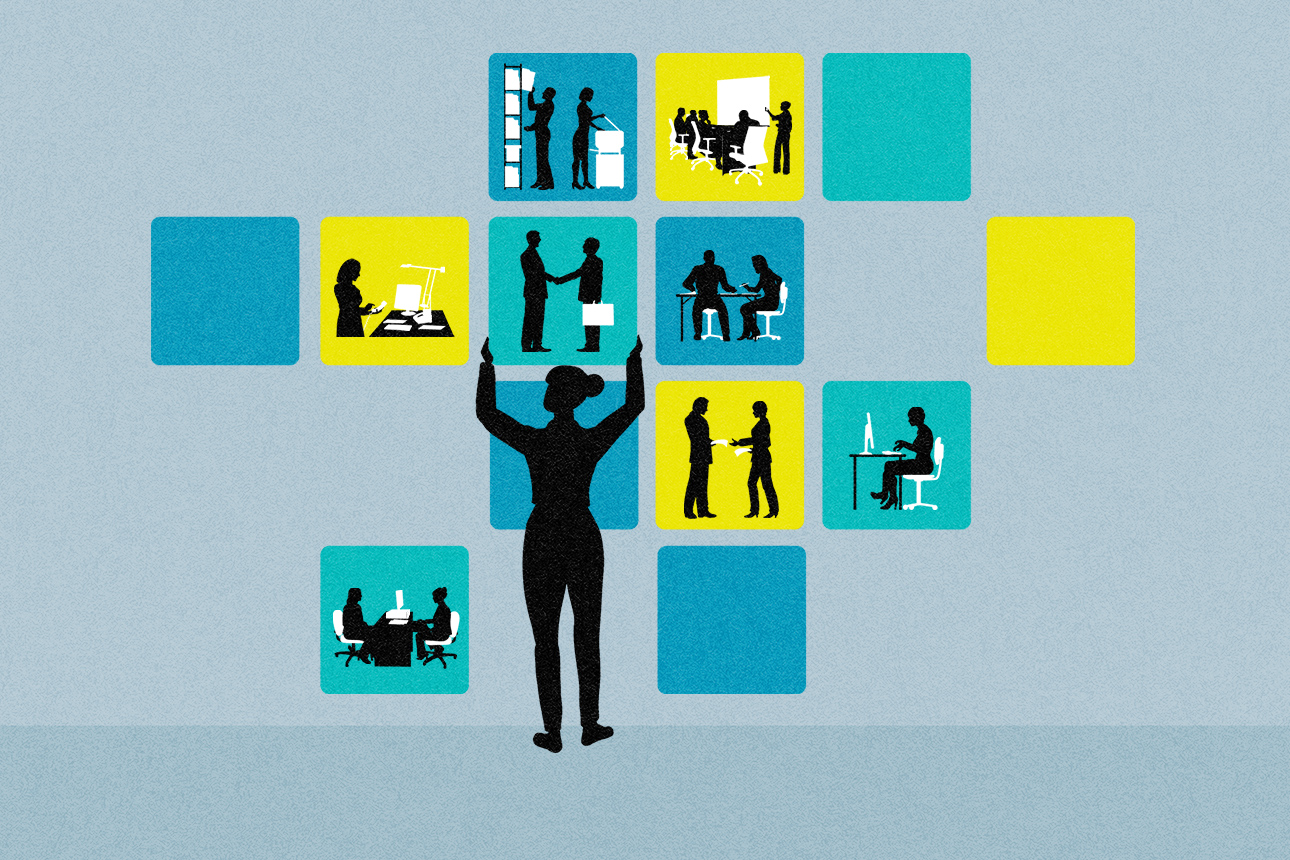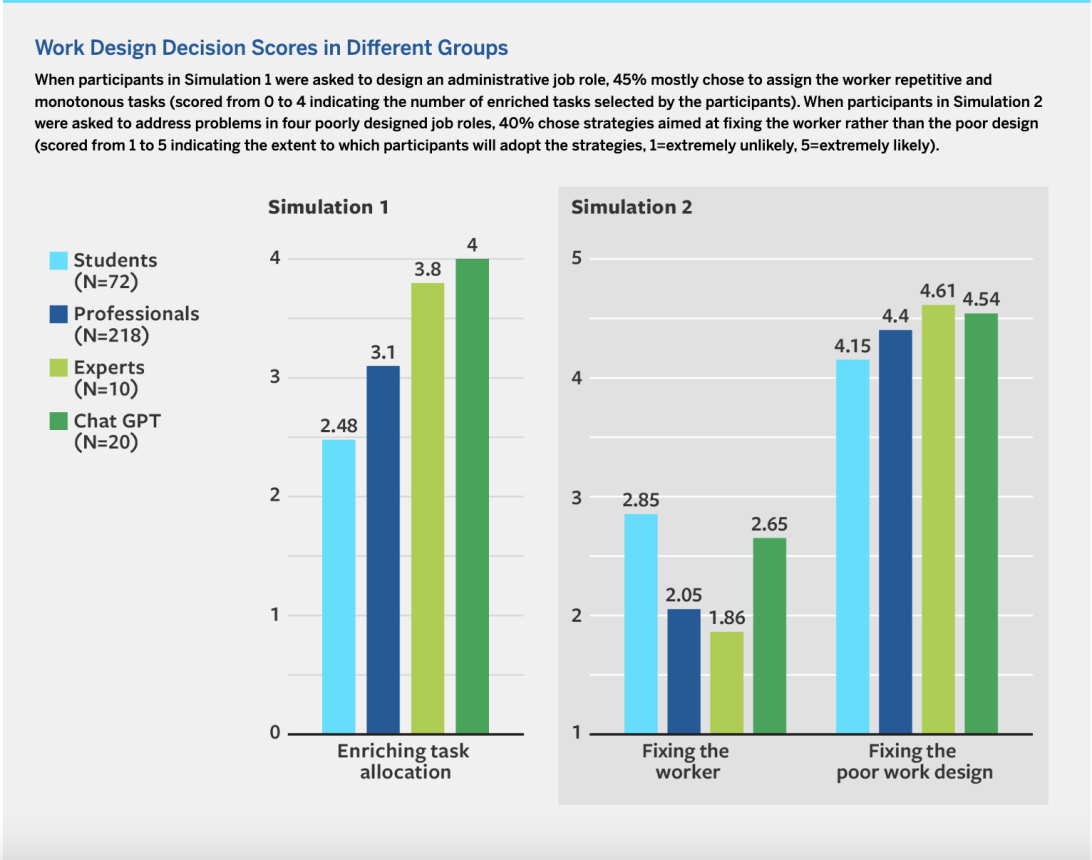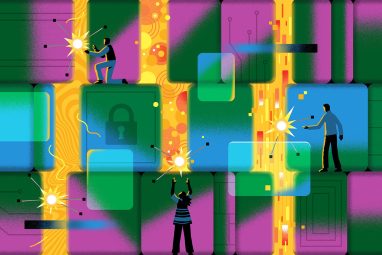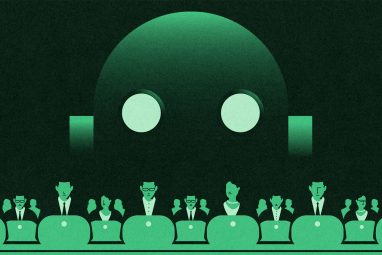How ChatGPT Can and Can’t Help Managers Design Better Job Roles
Many leaders don’t know how to design healthy, productive roles. ChatGPT proves effective here, when used wisely.
News
- Private Sector to Outpace Governments in $20 Billion Earth Intelligence Market
- Saudi Arabia to Add 112MW to Data Centre Capacity in New Deal
- UAE Dominates Global Data Centre Rankings as Region Becomes Digital Infrastructure Hotspot
- AI Adoption Climbs 233% Globally with the Middle East Showing Similar Momentum, Report finds
- du Launches UAE’s First Sovereign Hypercloud for Government and AI Innovation
- Ooredoo Launches Sovereign AI Cloud in Qatar Powered by Nvidia GPUs

Carolyn Geason-Beissel/MIT SMR | Getty Images
Today’s leaders are pushing to increase employee engagement and decrease turnover but face a harsh reality: widespread employee burnout. To fight it, managers need to offer employees more healthy and meaningful work. In surveys conducted in the United States by Gallup in 2022, 40% of employees reported that their job had a negative impact on their mental health, and around 30% said they frequently experience burnout. Moreover, U.S. employee engagement hit a seven-year low, with only 32% of workers polled by Gallup saying they were engaged and 17% saying they were actively disengaged in 2022.1 Globally, employees’ lack of engagement has been estimated to cost employers $7.8 trillion — equivalent to 11% of the global gross domestic product.2
The root causes of disengagement and work stress often lie in how an organization has designed people’s jobs. Decades of extensive research consistently link poor work design with negative employee outcomes, including mental strain, high turnover, job dissatisfaction, decreased productivity, and impaired learning.3 Many companies are now striving to do better.
Unfortunately, our research indicates that many managers lack the necessary understanding to design high-quality jobs. This is where artificial intelligence technologies such as ChatGPT could play a key role, by bridging the manager knowledge gap and helping design high-quality work that benefits both employees and organizations. However, it is important for managers to first understand the pros and cons of using ChatGPT for work design. Let’s explore some takeaways for managers that our research has revealed.
Managerial Challenges: Mundane and Unfulfilling Jobs
What factors determine whether a job is high quality? The SMART work design model, a framework created by Sharon K. Parker, defines high-quality work as work that is stimulating (jobs with task variety and a chance to develop new skills), incorporates mastery (such as role clarity and job feedback), is agentic (such as job autonomy and change participation), is relational (where social support and positive teamwork are available), and is tolerable (with manageable work hours and reasonable levels of time pressure).4
Despite the benefits of well-designed jobs, poorly designed ones are still prevalent. According to the Gallup 2019 Great Jobs Survey, only 40% of employed Americans are engaged in jobs that possess SMART characteristics.5 On the other hand, 16% find themselves in jobs that lack essential SMART characteristics, and 44% have jobs that possess only some satisfactory SMART attributes.6
A lack of knowledge among today’s managers about job design might explain such findings. A study we recently conducted explored how people design jobs for others.7 Participants in an online simulation (Simulation 1) were asked to design an administrative job role. The half-time job was made up entirely of four photocopying and filing tasks. Participants were asked to make the job full time by selecting four additional tasks from a list of 11, including five repetitive photocopying and filing tasks and six more-meaningful and interesting tasks, such as greeting visitors or helping colleagues arrange meetings.
Despite the benefits of well-designed jobs, poorly designed ones are still prevalent.
Participants were scored on a 0 to 4 range, with a higher score indicating the creation of a more stimulating work design. Almost half (45%) of university-level management students and professionals/managers working in human services industries tended to incorporate repetitive and monotonous work, demonstrating a knowledge gap when it comes to quality work design.
In a second simulation (Simulation 2), participants were asked to act like a manager and solve workforce problems in four scenarios. In each scenario, the job role design was clearly poor. To fix the problems, participants rated how likely they were to adopt strategies from a list that included both “fixing the worker” approaches, which attributed problems to the employee, and “fixing the poor work design” approaches, which acknowledged the poor-quality job design.
For example, in one scenario, a warehouse worker consistently failed to meet 50% of the timed deadlines in gathering products and delivering them to dispatch — despite frequently running to pick up goods. While the majority of participants focused on choices that improved the work design (for example, “Involve the employee and their colleagues in a review to identify ways in which their work could be organized better” or “Reorganize the work so that tasks do not need to be timed”), a surprising number of participants (40%) still chose strategies aimed at fixing the worker (such as “Discreetly observe the person’s behavior to see how fast they are moving”). These findings validate our finding that there is a lack of knowledge of work design among managers and staff members.
Generative AI Can Suggest Strong Work Design
In the study’s next phase, we researched whether an AI-powered tool such as ChatGPT could help managers do better. The short answer: ChatGPT has the potential to enhance decision-making in work design. However, it is important for managers to understand what ChatGPT can and cannot do well.
 We used ChatGPT to make hypothetical work design decisions for the administrative work design simulation (Simulation 1). We ran the simulation task 20 times, using a new, independent chat session with the same prompt each time in ChatGPT. The generative AI model consistently chose enrichment tasks out of the provided list, outperforming both students and professionals/managers in creating interesting and meaningful work. ChatGPT’s performance was similar to that of work design experts
We used ChatGPT to make hypothetical work design decisions for the administrative work design simulation (Simulation 1). We ran the simulation task 20 times, using a new, independent chat session with the same prompt each time in ChatGPT. The generative AI model consistently chose enrichment tasks out of the provided list, outperforming both students and professionals/managers in creating interesting and meaningful work. ChatGPT’s performance was similar to that of work design experts
We then tasked ChatGPT to tackle Simulation 2, addressing the four managerial workforce scenarios (including the theoretical warehouse worker mentioned above), choosing strategies from a list. In each scenario, ChatGPT consistently chose strategies aimed at fixing the work design (good strategies for employee well-being, motivation, and performance) over those focused on fixing the worker. As in Simulation 1, ChatGPT outperformed students, managers, and professionals in its focus on work design to solve the workforce problems.
However, ChatGPT did not score as well as the work design experts in Simulation 2, suggesting that some caution is warranted. For example, in one session addressing the warehouse worker who was missing deadlines, ChatGPT scored 4 overall but chose the strategy “I would give the employee and her colleagues a bonus when they meet the allocated times,” which ignores the role’s unreasonable time allocation.
One Big Lesson: Specific Prompts Are Key
To further assess ChatGPT’s ability to generate suggestions independently, we ran the Simulation 2 work design tasks without providing a multiple-choice solution list. We ran each test in a new account with the chat history function turned off and in independent new chats so that the output of ChatGPT would not be affected by previous inputs.
To begin with, the outcome was worrying. When we simply instructed the AI model to “provide effective strategies to address the problem” in the missed-deadlines scenario, ChatGPT tended to address problems by trying to fix the worker and creating old-fashioned Taylorist approaches to work systems, such as conducting time and motion studies. For example, ChatGPT suggested solutions such as time management skills and additional training to help the warehouse employee, who we named Karen, improve her performance (for example, “Focus on improving Karen’s speed and accuracy in locating and gathering items from the warehouse”). It also recommended providing performance feedback and incentives to motivate Karen to move faster (for instance, “By linking performance with rewards, Karen will be encouraged to focus on improving her speed and efficiency”). Each of these solutions implicitly assumes that the worker’s motivation or ability is the problem rather than the work design.
After learning that such an open-ended approach was not optimal, we next instructed ChatGPT to address this same scenario using specific prompts: “Consider designing a good-quality job for Karen”; “Consider Karen’s health, well-being, motivation, satisfaction, and work meaningfulness”; and “Consider Karen’s work design.” The AI model then provided solutions related to improving Karen’s work design, including the following:
- Reviewing time allocation and workload to set realistic time goals.
- Involving Karen in the decision-making process and seeking her input on ways to improve her job.
- Offering supportive feedback and recognition to enhance employee satisfaction and motivation.
- Providing adequate training and skill development opportunities to boost confidence and engagement.
These strategies would boost Karen’s SMART work design characteristics, increasing the tolerability of demands, enhancing agency, boosting mastery, and making the work more stimulating.
ChatGPT also suggested solutions such as fostering a supportive work environment, encouraging team support and collaboration, offering career advancement opportunities, and promoting work-life balance. These solutions all align well with extensive research on work design and well-being and would make the job “SMART-er” and hence result in a healthier and more productive employee.
We learned from this particular experiment with ChatGPT that generative AI can make valuable work design decisions, but managers need to provide clear instructions that prioritize outcomes for the worker. For example, asking ChatGPT to “design a high-quality job” rather than simply requesting “good work design” can generate more relevant and effective strategies. Therefore, to enhance the quality of strategy suggestions generated by ChatGPT, managers need to mention specific, desirable goals in their question prompts, such as high-quality jobs; employees’ health, well-being, and motivation; and work meaningfulness.
Generative AI can make valuable work design decisions, but managers need to provide clear instructions that prioritize outcomes for the worker.
One piece of good news: Managers who do not frequently use ChatGPT can learn how to write effective prompts via the ChatGPT tool itself. For example, when asked, “How can one craft a well-structured and clear prompt to effectively address work design challenges?” ChatGPT provided a step-by-step guide on how to write effective prompts. ChatGPT advised us to identify the core issue and be specific — suggestions that could be applied to work design by using prompts such as “Design high-quality work that enhances positive team interaction and collaboration for the sales team” or “Design work that is meaningful to facilitate employee acceptance of technological changes in their work.”
The experiment also showed that effective prompts need to be reviewed and tested. Managers who struggle to write effective ChatGPT prompts can improve their skills by using a prompt such as “The following is a prompt aimed at asking ChatGPT for advice from a work design expert’s perspective. Please analyze and suggest improvements to get actionable and practical advice from ChatGPT.” In this case, ChatGPT will provide more specific suggestions that drive better-quality outputs.
Five Lessons for Managers
To address the pervasive issue of poor work role design and its detrimental effects, embracing innovative solutions is crucial. Based on our research, ChatGPT has emerged as a promising AI-powered tool to help managers design healthier and more productive jobs. But it’s not a panacea and needs to be used wisely. Our advice for managers:
ChatGPT cannot replace training. Managers need to be aware that worker problems can emerge from poor work design and that work design, in turn, can affect worker well-being, motivation, and work meaningfulness. This means that before using ChatGPT to design better jobs, managers still need basic training on work design concepts. To get started on this topic, see the related article “How Well-Designed Work Makes Us Smarter” and the SMART Work Design site.
Managers need to be supported in their goal to create well-designed work. Managers need to be motivated to create better jobs for their staffs. This means managers themselves need roles in which the creation of healthy employee work roles is seen as a legitimate and important responsibility, versus having their sole focus be the bottom line. For example, if managers get promoted purely on the basis of productivity achievements, they will not have much motivation to design SMART work for their teams.
Managers need healthy jobs themselves. Managers need sufficient time to be able to pay attention to how well their staff members’ jobs are designed. This means managers’ own jobs need to be tolerable and not excessively time-pressured.
Managers need to learn ChatGPT prompting skills. Managers should be encouraged to use generative AI to help with work design challenges, but they need clear and comprehensive instructions as to how to use it effectively. For example, managers need to be specific and to mention goals such as employee well-being and motivation when seeking work design recommendations from ChatGPT.
ChatGPT will augment, not replace, people in designing better jobs. Unlike simulations, real-life job design situations are often characterized by their ambiguity and complexity, with numerous variables that can influence outcomes. Real situations require a deep understanding of context, human emotions, social dynamics, and political and ethical considerations, all of which can be challenging for an AI tool like ChatGPT to fully grasp. We recommend using ChatGPT as a complement to human managers rather than as a replacement for them.
By incorporating ChatGPT’s suggestions alongside human expertise, organizations can foster higher staff engagement, job satisfaction, and overall performance. Achieving such a synergy between managers and AI can pave the way for a better future for work design and employee experience.
References
- B. Wigert and R. Pendell, “6 Trends Leaders Need to Navigate This Year,” Jan. 31, 2023, Gallup, www.gallup.com.
- Ibid.
- S.K. Parker, “Beyond Motivation: Job and Work Design for Development, Health, Ambidexterity, and More,” Annual Review of Psychology 65 (January 2014): 661-691.
- S.K. Parker, “Smart Work Design,” Safeguard, May/June 2022, 50-53.
- J. Rothwell and S. Crabtree, “Not Just a Job: New Evidence on the Quality of Work in the United States,” PDF file (Washington, D.C.: Gallup, 2019), www.gallup.com.
- Ibid.
- S.K. Parker, D.M. Andrei, and A. Van den Broeck, “Poor Work Design Begets Poor Work Design: Capacity and Willingness Antecedents of Individual Work Design Behavior,” Journal of Applied Psychology 104, no. 7 (July 2019): 907-928.





